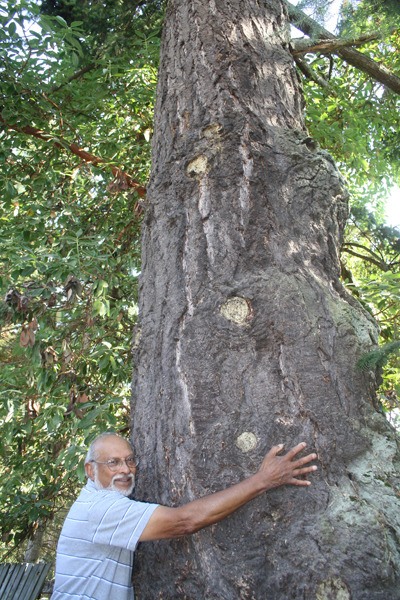A large Douglas fir, considered the most prominent tree on Winslow Way, came close to being one of several trees that have lost their lives during the street’s current improvement project.
Fortunately, two arborists and the City Council, belatedly, came to its rescue just in the nick of time.
The city’s Public Works Department had decided the tree, which is estimated to be somewhere between 80 and 100 years old by local arborist Olaf Ribeiro, had to be cut down after a Mount Vernon arborist who surveyed many of the street’s trees said it was unhealthy and dangerous.
Ribeiro got a stay of execution from the council a couple of weeks ago so that he and Seattle arborist Scott Baker could do more detailed analysis of the tree than did Mount Vernon consultant James Baborinas.
The tree straddles private (Tillicum apartments) and public property on the south side of the street and is nearly flush with the sidewalk that runs between State Route 305 and Bjune Drive. It is estimated to be about 70 feet tall and 46 inches in diameter at breast height.
As Baker put it: “This is an interesting old tree with great character. It has had many changes occur around it and has survived them all. Its condition at present indicated it is getting stronger, perhaps recovering from earlier road work near it.”
Baker and Ribeiro, both of whom did trunk and root testing on the tree, agreed that while there is decay in the middle of the trunk, it is minimal and failure is unlikely.
Barbarinos said he had inspected the tree in 2009 “with somewhat limited tools” and his assessment offered in a report recently submitted to the city “recommended removal based on the limited depth of sound wood and the declining nature of the tree” at the time of his assessment.
A letter dated Sept. 6, rescinded that recommendation in light of the more thorough assessments made by Ribeiro and Baker, whose reports found a growth of “more sound wood” during the last two years.
“The results of the Tomograph (a tool used by Baker to x-ray the tree’s lower trunk) indicate there is greater sound wood in that portion of the tree trunk than I was able to detect with the Resistograph (he used to evaluate the tree),” wrote Barborinas.”
He said the increase “and improved vigor reduces the concern for failure and provides some justification for retention.”
All three of the arborists agreed that the tree needs regular pruning because the limbs are large and heavy, and must be inspected regularly. They also said the city would have to accept some risk because of the tree’s location and age.
And that’s where the City Council came in on Wednesday’s meeting. The council’s previous stance on the tree was drawn primarily from Barborinas’ initial consulting evaluation, and most of the members had not had much time to read the reports of the other two arborists.
Essentially, Barry Peters and Bob Scales believed the risks outweighed saving the tree, while the other four councilors in attendance eventually sided with the tree.
“This is a tree not appropriate for this location because it is dangerous,” Scales said. “The decision is about how much risk we are going to accept. Fine for consultants to say we need to preserve the tree, but they aren’t on the hook if something happens.”
Peters said the city, at a time of budget cutbacks, shouldn’t commit itself to an isolated tree repair program for a tree diagnosed as dangerous.
Instead, he said: “I feel honoring the tree by using some of its commemorative branches or other artifacts to be a very fitting tribute.”
Ribeiro, whose inspection was primarily of the tree’s roots, countered that “taking out the whole tree will be very expensive.”
As far as doing something with the tree as part of a historical idea, Ribeiro said, “it will be cheaper if you leave the bottom 10 to 15 feet and carve a totem pole.”
He said he assesses tree risk for a living and “we can’t control what happens with the weather and winds. But all things being equal, we have guidelines over whether a tree can be saved or not, and I feel comfortable about this tree.”
Ribeiro also advised the council next to “get more than one arborist’s opinion for a tree of this much importance to the community. It’s the largest tree in the whole downtown area and there is nothing like it in the downtown area.”
Councilor Kim Brackett said the tree is worth taking the risk, “which we now learn is not as great.”
She said she considers the tree needs to be honored, “but by keeping it alive. This is about priorities, community spirit and values that you can’t put a dollar amount on. Not all our decisions should be about money, budget risk. I personally feel we should save the tree and have it be a budgetary issue just like landscaping around City Hall.”
Hilary Franz, Debbi Lester and Kirsten Hytopoulos agreed.


